
Phalangeriformes is a paraphyletic suborder of about 70 species of small to medium-sized arboreal marsupials native to Australia, New Guinea, and Sulawesi. The species are commonly known as possums, gliders, and cuscus. The common name "possum" for various Phalangeriformes species derives from the creatures' resemblance to the opossums of the Americas. However, although opossums are also marsupials, Australasian possums are more closely related to other Australasian marsupials such as kangaroos.

Petauridae is a family of possums containing 11 species: four species of trioks and striped possum, six species of wrist-winged glider, and Leadbeater's possum, which has only vestigial gliding membranes. Most of the wrist-winged gliders are native to Australia, whereas most of the striped possums to New Guinea, but some members of each group are found on both sides of the Torres Strait. Leadbeater's possum is endemic to Victoria, Australia.
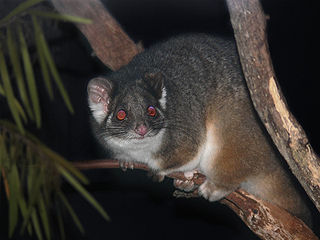
The common ringtail possum is an Australian marsupial.

Pseudocheirus is a genus of ringtail possums. It includes a single living species, the common ringtail possum of Australia, as well as the fossil Pseudocheirus marshalli from the Pliocene of Victoria.
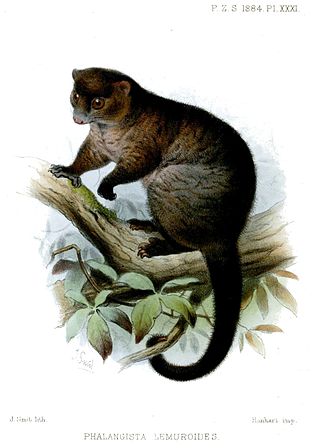
The lemuroid ringtail possum, also known as the lemur-like ringtail possum or the brushy-tailed ringtail, is a truly singular member of the ringtail possum group. It was once thought that they were greater gliders ; Hemibelideus literally translates as "half-glider". Named for their facial characteristics visually similar to the unrelated primate lemurs, with short snouts, large, forward-facing eyes and small ears, they are similar to other gliding possums in their musculo-skeletal adaptations to accommodate a leaping lifestyle. Their long, prehensile tail is a further adaptation to their arboreal habitat.

The greater gliders are three species of large gliding marsupials in the genus Petauroides, all of which are found in eastern Australia. Until 2020 they were considered to be one species, Petauroides volans. In 2020 morphological and genetic differences, obtained using diversity arrays technology, showed there were three species subsumed under this one name. The two new species were named Petauroides armillatus and Petauroides minor.

The Daintree River ringtail possum, also known as the cinereus ringtail possum, is a species of possum found in northeastern Queensland, Australia. It was long believed to be the same as the Herbert River ringtail possum, but has recently been separated. The two species differ considerably in appearance.
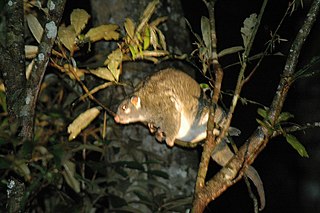
False ringtail possums (Pseudochirops) are members of a genus of marsupial in the family Pseudocheiridae. It contains the following species:
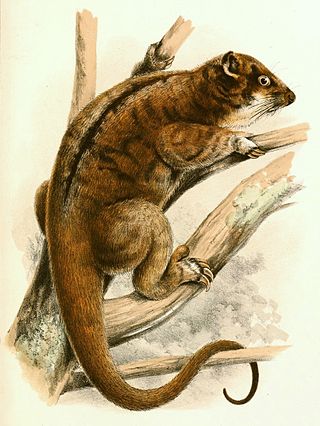
The plush-coated ringtail possum or golden ringtail possum is a species of marsupial in the family Pseudocheiridae. It is found in Indonesia, Papua New Guinea, and the Solomon Islands. Its natural habitat is subtropical or tropical dry forests.
Slender ringtail possum or Small ringtail possum (Pseudochirulus), also known as the ringtail possum, is a genus of marsupial in the family Pseudocheiridae native to Indonesia, Papua New Guinea and Queensland, Australia. Pseudochirulus live on trees and their diet mainly consists of leaves. The ringtail possums are related to five other genera Hemibelideus, Petauroides, Petropseudes, Pseudocheirus and Pseudochirops.

The painted ringtail possum or moss-forest ringtail possum is a species of marsupial in the family Pseudocheiridae. It inhabits montane forests between altitudes of 450 to 3800 metres throughout the Huon Peninsula montane rain forests, Central Range montane rain forests and Huon Peninsula montane rain forests of Papua New Guinea. It has a diet of primarily leaves, including those of Medinilla.
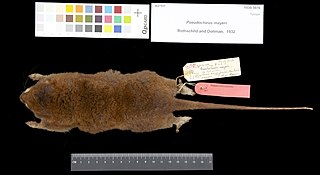
The pygmy ringtail possum is a species of marsupial in the family Pseudocheiridae. It is found in the montane forest regions of Papua New Guinea and West Papua, Indonesia. They are "widespread along the Central Cordillera" and live at elevations between 1,500 and 3,600 metres above sea level.”

The western ringtail possum or ngwayir is a species of possum found in a small area of Southwest Australia. They are a cat-sized marsupial with a stocky build, dark greyish-brown fur, pale underparts and a long prehensile tail with a whitish tip. Ngwayir forage at night through the upper canopy of trees, feeding on young leaves, flowers and fruit, especially in groves of the weeping peppermint Agonis flexuosa. Breeding occurs mainly during the winter, the single juvenile emerging from the pouch after about three months. The population has declined by more than 95% since British settlement, due to clearing of habitat, fire and the introduction of the red fox Vulpes vulpes, and is classified as Critically Endangered. The population in most areas has catastrophically declined or become locally extinct, but strongholds remain in the urbanised areas near Busselton and Albany.
Ringtail, ring tail, or ring-tail may refer to:

Petauroidea is a superfamily of marsupials from Australia and New Guinea. It is part of the suborder Phalangeriformes within the order Diprotodontia, which also includes, among others, wombats, kangaroos, cuscuses. The superfamily Phalangeroidea, including cuscuses and brushtail possums and pygmy possums, is the immediate sister group of the Petauroidea. The earliest fossils from this superfamily are from the Oligocene of the Geilston Bay fossil site in Tasmania.

















